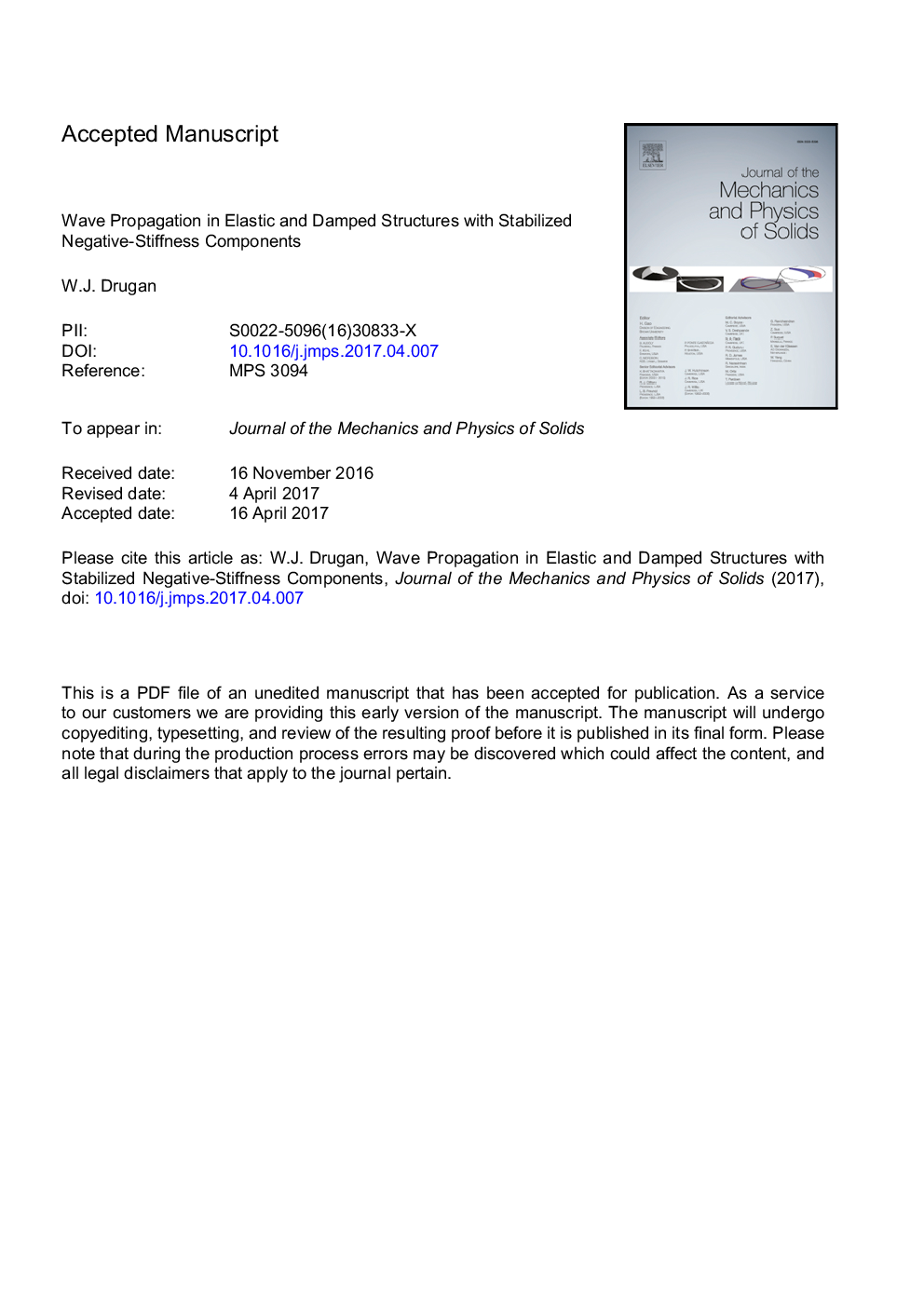| کد مقاله | کد نشریه | سال انتشار | مقاله انگلیسی | نسخه تمام متن |
|---|---|---|---|---|
| 5018088 | 1467037 | 2017 | 21 صفحه PDF | دانلود رایگان |
عنوان انگلیسی مقاله ISI
Wave propagation in elastic and damped structures with stabilized negative-stiffness components
ترجمه فارسی عنوان
انتشار موج در ساختارهای الاستیک و مضر با اجزای تثبیت شده منفی سختی
دانلود مقاله + سفارش ترجمه
دانلود مقاله ISI انگلیسی
رایگان برای ایرانیان
ترجمه چکیده
تاثیرات بر روی انتشار موج که توسط معرفی یک مولفه منفی-سفتی قابل دستیابی است از طریق شاید ساده ترین عنصر تکرار گسسته که می تواند در حضور مولفه ثابت باقی بماند بررسی می شود. هنگامی که سیستم الاستیک است، تنظیم مناسب از سفتی منفی مؤلفه پایدار، یک منطقه بدون عبور را به وجود می آورد که از لحاظ تئوری از صفر تا فرکانس به طور دائمی افزایش می یابد، قابل تعدیل با تنظیم نسبت وزن. هنگامی که مولفه ی منفی سختی به حد ثبات سیستم تنظیم می شود و نسبت جرم به اندازه کافی کوچک است، سیستم انتشار را به امواج تقریبا یک فرکانس دلخواه محدود می کند، قابل تنظیم با تنظیم نسبت سفتی اجزای مثبت سختی. راه حل های عمومی سیستم الاستیک بسته به شکل و شفاف است. در هنگام اضافه کردن، تنظیمات عمومی هنوز بسته شده اند، اما پیچیده است، به طوری که آنها به وضوح نشان نمی دهد که چگونه مولفه های سختی منفی بر روی پاسخ سیستم تاثیر می گذارد و چگونه باید برای رسیدن به نتایج مطلوب تنظیم شود. راه حل های تقریبی با استفاده از این ویژگی ها از طریق چهار تحلیل تحریف شده به دست می آید: یکی برای طول موج های طولانی؛ یکی برای خرد کردن کوچک؛ و دو برای روابط کوچک. راه حل طول موج های طولانی نشان می دهد که تنظیم مناسب اجزای سختی منفی می تواند موجب انتشار امواج طولانی مدت شود. راه حل کم محفظه نشان می دهد که محدوده فرکانس پایین با فرکانس پایین صفر باقی می ماند، در حالی که امواج که پخش می شوند بسیار کم است، در حالی که یک نسبت جرم کوچک است. در نهایت، اثرات بسیار جالبی در حد پایداری کامل سیستم قابل دستیابی است. برای مقادیر کوچک جرم، دامنه طول موج امواج ممنوعه از انتشار می تواند از طریق تنظیم فشار کم تنظیم شود: هنگامی که یک نسبت جرم کوچک باشد، تمام امواج با طول موج های بزرگتر از یک مقدار تنظیم شده با تنظیم دلخواه می توانند ممنوع باشند از انتشار، در حالی که معکوس از این نسبت جرم کوچک است، تمام امواج با طول موج خارج از یک ارزش تنظیم مجاز خودسرانه و یا طیف وسیعی از مقادیر را می توان از انتشار ممنوع است. تمام راه حل های تقریبی پیش بینی های تحلیلی شفاف با راه حل دقیق تایید می شود. نتیجه گیری این است که یک جزء منفی سخت افزاری ثابت شده تنظیم شده به طور قابل توجهی کنترل انتشار موج را در یک سیستم صرفا الاستیک تقویت می کند و وقتی که اضافه شدن قابل تنظیم می شود، کنترل بیشتر آسان تر می شود.
موضوعات مرتبط
مهندسی و علوم پایه
سایر رشته های مهندسی
مهندسی مکانیک
چکیده انگلیسی
Effects on wave propagation achievable by introduction of a negative-stiffness component are investigated via perhaps the simplest discrete repeating element that can remain stable in the component's presence. When the system is elastic, appropriate tuning of the stabilized component's negative stiffness introduces a no-pass zone theoretically extending from zero to an arbitrarily high frequency, tunable by a mass ratio adjustment. When the negative-stiffness component is tuned to the system's stability limit and a mass ratio is sufficiently small, the system restricts propagation to waves of approximately a single arbitrary frequency, adjustable by tuning the stiffness ratio of the positive-stiffness components. The elastic system's general solutions are closed-form and transparent. When damping is added, the general solutions are still closed-form, but so complex that they do not clearly display how the negative stiffness component affects the system's response and how it should best be tuned to achieve desired effects. Approximate solutions having these features are obtained via four perturbation analyses: one for long wavelengths; one for small damping; and two for small mass ratios. The long-wavelengths solution shows that appropriate tuning of the negative-stiffness component can prevent propagation of long-wavelength waves. The small damping solution shows that the zero-damping low-frequency no-pass zone remains, while waves that do propagate are highly damped when a mass ratio is made small. Finally, very interesting effects are achievable at the full system's stability limit. For small mass ratios, the wavelength range of waves prohibited from propagation can be adjusted, from all to none, by tuning the system's damping: When one mass ratio is small, all waves with wavelengths larger than an arbitrary damping-adjusted value can be prohibited from propagation, while when the inverse of this mass ratio is small, all waves with wavelengths outside an arbitrary single adjustable value or range of values can be prohibited from propagation. All of the approximate solutions' analytically-transparent predictions are confirmed by the exact solution. The conclusions are that a stabilized tuned negative-stiffness component greatly enhances control of wave propagation in a purely elastic system, and when adjustable damping is added, even further control is facilitated.
ناشر
Database: Elsevier - ScienceDirect (ساینس دایرکت)
Journal: Journal of the Mechanics and Physics of Solids - Volume 106, September 2017, Pages 34-45
Journal: Journal of the Mechanics and Physics of Solids - Volume 106, September 2017, Pages 34-45
نویسندگان
W.J. Drugan,
